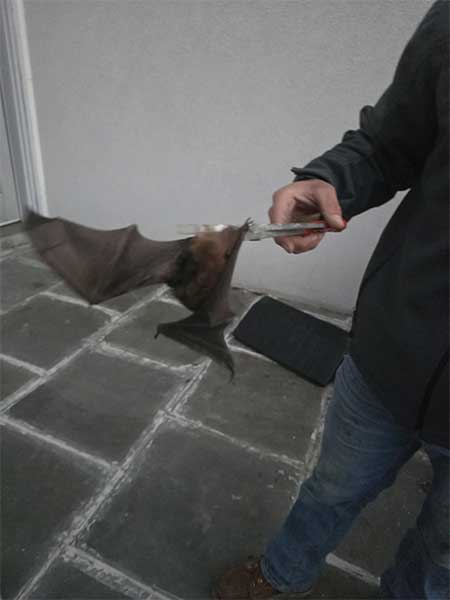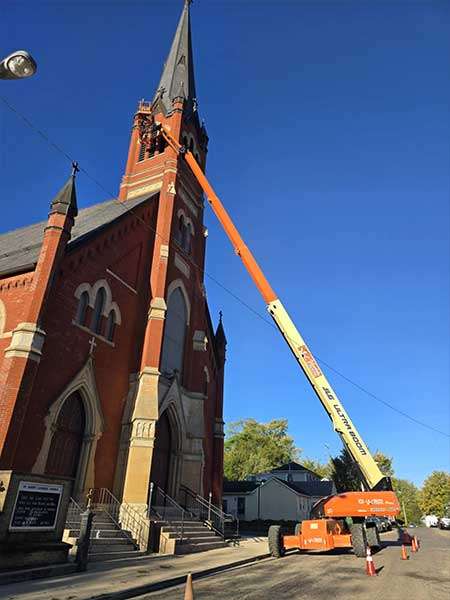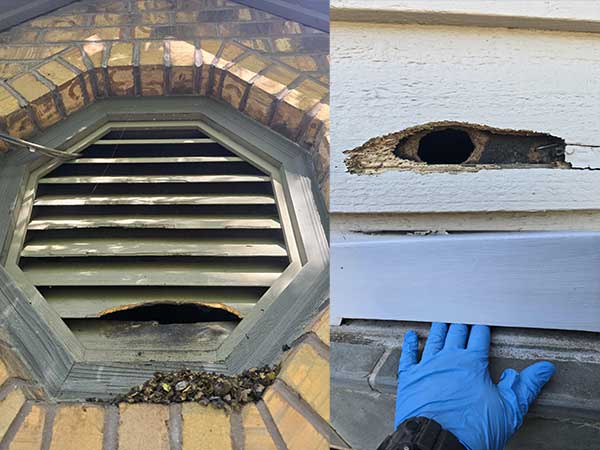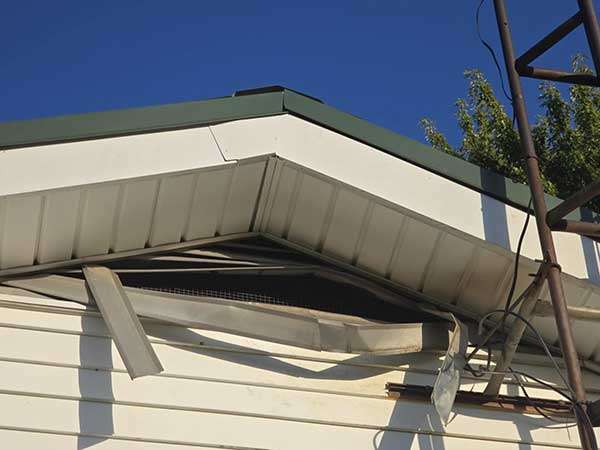Barnes Wildlife Control Is Your Dayton On Call Wildlife Control Company Of Choice
Here at Dayton On Call Wildlife Control, provided by Barnes Pest Removal, we strive to provide fast service. We can often be there the same day you call us at (937) 340-1867 to schedule an inspection of the animals in the attic. Our On Call Wildlife Control service is only successful due to having a well-trained, fully staffed office and over a dozen full-time wildlife removal field technicians.
Most days we receive over 50 calls per day here at on call wildlife control. With that many customers calling to discuss their pest control needs, we excel at managing our trapping routes and scheduling to reach everyone. Providing excellent customer service is key to being the best on call wildlife control company in Dayton, Ohio.
Dealing with Critters in the Attic During the Busy Season
The months between April through June and August through October are the busiest times when a nuisance varment is active in Dayton area homes. The primary place that raccoons and squirrels enter the home are on the roof. The roof typically has entry points at a ridge vent, which can be protected from animals entering the attic by installing a Peak Protector. Bats and mice will also take advantage of roof gaps to enter the home but don’t lose sleep with Barnes’ on call wildlife control.
Raccoons start nesting for birthing during March and have 3 to 4 kits (babies) in the attic insulation. Other critters can get into the attic from areas along the foundation and along the fascia. The most common animals we encounter using lower entry points are mice and pine squirrels. Mice will, however, climb up the sides of the home and enter along the drip edge if the opportunity arises. If you experience critters causing you a problem, seek out the best varment guard service in Southwest Ohio by contacting Barnes Wildlife Control.
Humanely captured bat from a Dayton building. Barnes Wildlife Control is a bat removal expert.
Bat exclusion often demands working at great heights as seen in the above photo. We had to do a bat exclusion from this Dayton church.
Guard Your Home From A Varment Intrusion
The best way to protect your most valuable investment (your home) is to guard against damage from animal pests. Both insect and animal pests will not only keep you up at night, but they can also cost you thousands of dollars in home damage.
A List Of Common Things Varmints Can Damage
1) Attic Insulation Damage
Once inside an attic, critters may tear, chew, or burrow into insulation material to create nests, compromising its effectiveness. Insulation torn apart or compacted loses its ability to regulate temperature properly, leading to higher energy costs.
Animal urine and feces can contaminate insulation, creating foul odors and spreading diseases. In addition, moisture from urine can lead to mold growth, further damaging insulation and affecting indoor air quality.
2) Electrical Wire Damage
Squirrels, rats, raccoons, and mice can cause severe damage to electrical wires. These animals often chew on wires, stripping away the protective insulation.
When the insulation around wires is damaged, it exposes the metal conductors, leading to short circuits, electrical malfunctions, or even fires. The fire risk is exceptionally high in confined spaces like attics, where chewed wires can spark near insulation materials or wooden structures. Chewed wires can also lead to power outages, electrical shocks, and costly home repairs.
Wildlife can access electrical wiring in attics, walls, basements, or other hidden spaces, making the damage hard to detect until a problem occurs. Addressing wildlife infestations quickly is crucial to preventing potential electrical hazards and ensuring the home’s safety. Implementing effective exclusion measures and repairing damaged wires is essential to prevent further issues.
3) Drywall Damage
Wildlife often chews through drywall to create entry points or to access shelter, food, or nesting sites. Once inside walls, wildlife may scratch, claw, or dig into drywall to expand their space or create nesting areas. This physical damage weakens the structure, leading to holes or cracks.
Wildlife can also contaminate drywall with urine and feces, which can cause staining and foul odors and promote mold or mildew growth. Over time, this damage can compromise the integrity of walls, leading to costly repairs.
Additionally, drywall damaged by wildlife may go unnoticed until the damage becomes severe, making it crucial to address wildlife infestations promptly. Sealing entry points and repairing damaged drywall can help restore the home’s structure and prevent future infestations.
4) Vent Damage
Vents provide access points to attics, crawl spaces, and duct systems, making them attractive to wildlife seeking shelter or a place to nest. Animals often chew, claw, or peck at vent coverings, weakening or dislodging them to gain entry.
Wildlife can damage the internal components of ventilation systems. Birds and rodents may build nests that obstruct airflow, reducing the efficiency of heating or cooling systems. In addition to physical blockages, nests and droppings can contaminate the air quality inside the home, leading to health risks from allergens or disease.
Chewing or tearing vent screens can also create openings for more pests to enter, leading to further infestations and potential structural damage. The compromised vent covers allow rain and debris to enter, which can contribute to water damage or mold growth.
To prevent wildlife damage, it’s important to install durable vent covers, regularly inspect vents for signs of tampering, and address any infestations quickly. Proper exclusion and repair of damaged vents help ensure the home’s ventilation system operates efficiently and remains pest-free.
Wildlife will enter your home or buildings in numerous ways to stay warm during the colder weather. Proper exclusion strategies are important.
Raccoons are masters at tearing their way into buildings where they can raise their young and stay warm during colder weather.
5) Siding Damage
Pest animals may chew, claw, or peck at siding materials like wood, vinyl, or aluminum to create entry points into walls or attics. Rodents, in particular, chew continuously to wear down their growing teeth, leading them to gnaw through siding, often near corners, windows, or rooflines.
Once siding is breached, wildlife can access the interior of walls, leading to insulation damage, contamination from urine and feces, and nesting inside the structure. Birds may peck at wooden siding to build nests, while larger animals like raccoons or squirrels can tear away pieces of siding in search of shelter.
Damaged siding compromises the home’s structural integrity and allows moisture to seep in, causing water damage, mold growth, and deterioration of underlying materials. Openings created by wildlife can also invite further infestations from insects and other pests.
Regular inspections, sealing entry points, and swift repairs of damaged siding are essential to preventing wildlife intrusion and preserving the home’s exterior. Proper exclusion techniques help maintain the siding’s durability and protect the home from further wildlife damage.
6) Shingle Damage
Wildlife, such as squirrels, raccoons, and birds, can cause significant damage to roof shingles. These animals often access rooftops in search of shelter, nesting sites, or food, and shingles are one of the first barriers they encounter. Squirrels and raccoons, for example, may claw, bite, or tear shingles to gain entry into attics or roof spaces. This behavior can dislodge or break shingles, leaving gaps or exposed areas vulnerable to the elements.
Damaged shingles can lead to water infiltration during rain, causing leaks, rot, and mold growth within the roof structure. Birds, especially woodpeckers, may peck at shingles, damaging them and creating small holes that compromise the roof’s protective layer. Over time, these holes allow moisture to seep in, further deteriorating the roofing materials.
Once shingles are damaged, the roof becomes susceptible to more extensive structural issues, which can lead to costly repairs. The presence of wildlife can also attract other pests, worsening the damage. Regular roof inspections and prompt repairs of damaged shingles, along with effective wildlife exclusion measures, can help maintain the roof’s integrity and protect the home from further wildlife-induced damage.
7) Gutter Damage
Squirrels, raccoons, birds, and rodents often access gutters to travel along rooftops, seek shelter, or find nesting materials. Squirrels and raccoons may chew on gutter edges or claw at the material, causing dents, cracks, or even dislodging sections. Birds frequently build nests inside gutters, leading to clogs that prevent proper water drainage.
Blocked gutters can overflow, leading to water damage on roofs, fascia boards, and even the home’s foundation. Overflowing water may also cause soil erosion around the home and increase the risk of basement flooding. Prolonged water exposure due to clogged gutters can result in mold growth, wood rot, and deterioration of the roof’s structure.
Additionally, rodents may use gutters as access points to enter attics or wall spaces, creating further damage inside the home. Wildlife activity in gutters can also lead to the accumulation of debris, such as leaves and twigs, exacerbating the risk of blockages.
To prevent wildlife damage, it’s essential to regularly clean gutters, install protective guards, and ensure there are no gaps or weak points that animals can exploit. Timely gutter maintenance helps prevent costly repairs and keeps the home safe from water damage.
8) Aluminum Drip Edge Damage
Wildlife pests like squirrels, raccoons, and birds can cause damage to aluminum drip edges, which are designed to protect roofs by directing water away from the fascia and into the gutters. Animals often access roofs and may chew, claw, or peck at aluminum drip edges in their attempts to enter attics or wall cavities.
Squirrels and raccoons, known for their strong teeth and claws, can bend, dent, or tear aluminum drip edges, compromising their ability to channel water effectively. Once the drip edge is damaged, water can seep behind the fascia and into the roof structure, leading to leaks, water damage, and potential wood rot. Birds may also peck at aluminum drip edges, causing small holes or deformities that can lead to moisture infiltration.
Damaged drip edges can create access points for other wildlife to enter the home, further worsening the situation. Additionally, compromised drip edges may cause gutters to function improperly, resulting in water pooling near the roof or foundation, leading to mold growth or structural damage.
Regular inspections and prompt repairs to aluminum drip edges, along with effective wildlife exclusion measures, are essential to maintaining a functional roof system and preventing costly water-related repairs.
If you decide to fix these items, consider our Barnes’s Dayton On Call Wildlife Control damage repair service. We guarantee all of our work and make repairs look like there was never an animal problem. Barnes Wildlife Control is proud to serve our Dayton community!




